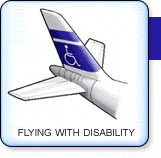|
|
Flying With Disability
| Boarding and exiting the aircraft |
|
Trained personnel should be ready to assist you when boarding and exiting the aircraft. If a ramp is not available, then a lifting device must be provided to enable the traveller to enter the aircraft.
With regard to smaller aircrafts, it may be the case that no lifting equipment is available, though the development of this type of equipment is currently underway.
If the traveller has a connecting flight, the carrier delivering the individual has the responsibility to assist in the movement of the traveller to the connecting flight. Airlines tend to give priority to disabled travellers, allowing them to pre-board the airline first.
On aircrafts with 100 seats or more, priority space in the cabin is offered to store the passenger's wheelchair. If the plane has more than one aisle, then at least one accessible lavatory should be available, with sufficient room for the passenger to manoeuvre using an on-board wheelchair.
If the aircraft has more than 60 seats, then it must accommodate an on-board wheelchair if there is an accessible lavatory, or if a passenger contacts the airline prior to flying and states that he or she is capable of using an inaccessible lavatory, if he or she can access it.
Unfortunately, aircrafts made prior to 1992 do not have to adhere to these rules and regulations, though any refurbishment made must incorporate facilities to support disabled travellers.
|
|
|
